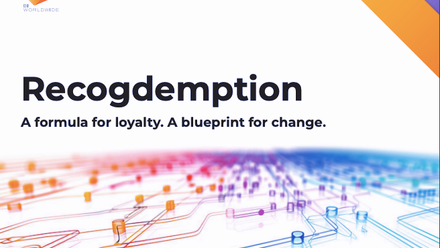10 ways the strategic use of recognition is changing
Once seen as a nice-to-have, recognition in the workplace is now a proven driver of engagement, retention, wellbeing and performance - especially in a hybrid-working world where connection is harder to maintain.
O.C. Tanner’s 2025 Global Culture Report, which surveyed over 38,000 employees globally (including nearly 5,000 in the UK), found:
- Employees are eight times more likely to feel a strong sense of belonging when recognition is frequent and meaningful
- Workers are five times more likely to stay for two years or more
- Burnout is 87% less likely in UK organisations with a culture of appreciation
For HR and reward leaders, the message is clear: recognition is no longer optional. And it’s evolving fast.
Here are ten evolving practices every HR and reward leader should consider when building a recognition-first culture
1. Make recognition an everyday habit
Recognition is shifting from being a one-off moment to an everyday practice. In high-performing cultures, it’s embedded into routines - team meetings, project wrap-ups, even onboarding.
This is especially critical in hybrid workplaces, where visibility is limited.
Strategic takeaway: Embed recognition into daily interactions using platforms that support real-time, values-based recognition.
2. Empower peer-to-peer recognition
Recognition shouldn’t only flow top-down. When employees recognise each other, it builds authenticity, strengthens trust, and creates shared responsibility for culture.
Tools that enable quick peer shoutouts or employee-voted awards (like “Culture Champion” or “Unsung Hero”) create a sense of connection and shared ownership.
Strategic takeaway: Encourage peer recognition to build inclusion and cross-functional collaboration.
3. Prioritise real-time praise over delayed praise
Waiting until the end of the quarter or year to say “well done” is too late. Recognition is more motivating and meaningful when it happens at the moment of impact.
Real-time feedback boosts momentum and encourages the repeat of high-value behaviours.
Strategic takeaway: Use digital tools to recognise achievements instantly - while they’re still fresh and relevant.
4. Let data drive your recognition strategy
Recognition is no longer guesswork. With the right tech, HR leaders can track who’s being recognised, how often, and for what - helping identify culture carriers and gaps.
These insights can also be linked to performance, DEI, and wellbeing metrics.
Strategic takeaway: Incorporate recognition data into your people analytics to drive strategic decisions and equity.
5. Tailor recognition to individual preferences
Some people value public praise; others prefer a private thank-you. Cultural backgrounds, personality types, and neurodiversity all influence how recognition is received.
Modern platforms allow employees to set preferences, making it easier for managers to personalise.
Strategic takeaway: Train managers to tailor their recognition style — and use tools that make this easy.
6. Make praise specific and impact-driven
Generic “great jobs” don’t stick. Recognition is more effective when it clearly links effort to impact.
For example: “Your Q2 report clarified our client strategy and helped us close the deal.” This reinforces what good looks like and builds a sense of purpose.
Strategic takeaway: Recognise outcomes, not just effort. Be clear about why the contribution mattered.
7. Offer meaningful, flexible rewards
Recognition is strengthened when it’s backed by rewards that feel personal and relevant. The same old gift card won’t excite everyone.
Points-based systems with broad redemption options (from wellness, experiences or charitable donations) add real value and boost emotional connection.
Strategic takeaway: Let employees choose how they’re rewarded - it increases perceived value and satisfaction.
8. Elevate recognition to a strategic pillar
Recognition is one of the most cost-effective levers for driving loyalty and culture - yet still underused in many organisations.
The most successful organisations treat it as a core people strategy - not a perk. They align it with purpose, values, and strategic goals.
Strategic takeaway: Make recognition a board-level priority. Measure its impact and link it to outcomes.
9. Celebrate the everyday - not just the exceptional
Recognition often focuses on big wins or high-profile projects. But consistent, behind-the-scenes contributions keep the business running - and deserve celebration too.
Recognising small but meaningful acts reinforces value, belonging, and motivation.
Strategic takeaway: Encourage leaders to spotlight day-to-day efforts. It promotes equity and builds long-term morale.
10. Connect recognition to the bigger picture
Recognition is most powerful when it connects individual work to wider organisational goals. During times of change, this clarity boosts engagement and resilience.
Whether it’s sustainability, innovation, or inclusion - tying praise to purpose helps employees see the “why” behind their work.
Strategic takeaway: Use recognition to reinforce alignment with mission and values - especially in periods of transition or growth.
Recognition is your most underleveraged advantage.
It’s not just a gesture of appreciation - it’s a lever for aligning people with purpose, unlocking performance, and shaping a culture where talent thrives.
Done right, recognition isn’t just a moment - it’s a movement.
Supplied by REBA Associate Member, Avantus
Flexible Benefits & Technology specialist providing online, highly configurable platforms to Customers and Intermediaries worldwide.








